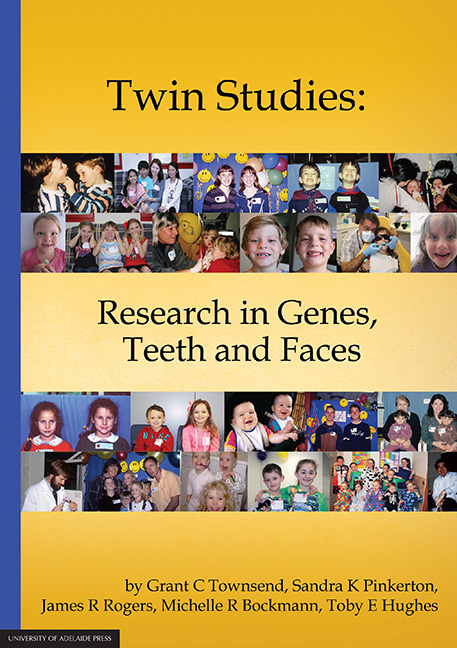Book contents
- Frontmatter
- Foreword
- Preface
- Dedication
- Photographic acknowledgements
- Ethical approval
- Acknowledgements
- Contents
- Chapter One A tour of the mouth
- Chapter Two A historical perspective
- Chapter Three Phases of research involving twin studies of teeth and faces
- Chapter Four Cohort 1: Teeth and faces of South Australian teenage twins
- Chapter Five Cohort 2 – A longitudinal study of dental and facial development in Australian twins and their families
- Chapter Six Cohort 3 – Tooth emergence and oral health in Australian twins and their families
- Chapter Seven Publications and theses relating to the Adelaide Twin Studies
- Glossary of terms
- Appendix 1
Foreword
Published online by Cambridge University Press: 05 February 2016
- Frontmatter
- Foreword
- Preface
- Dedication
- Photographic acknowledgements
- Ethical approval
- Acknowledgements
- Contents
- Chapter One A tour of the mouth
- Chapter Two A historical perspective
- Chapter Three Phases of research involving twin studies of teeth and faces
- Chapter Four Cohort 1: Teeth and faces of South Australian teenage twins
- Chapter Five Cohort 2 – A longitudinal study of dental and facial development in Australian twins and their families
- Chapter Six Cohort 3 – Tooth emergence and oral health in Australian twins and their families
- Chapter Seven Publications and theses relating to the Adelaide Twin Studies
- Glossary of terms
- Appendix 1
Summary
This book presents a unique account of a comprehensive research program on the genetics of teeth and faces, carried out over three decades at the School of Dentistry within the University of Adelaide by Professor Grant Townsend and colleagues. It is unique in several senses, firstly in that perhaps no other centre in the world has carried out such a long-term and wide-ranging program on so many facets of dentistry and craniofacial biology. But it is also unique in the sense that I know of no other academic endeavour that has so thoroughly documented its own history and intellectual progression, including the description not just of the main projects but also the smaller side-projects and all the people, including other researchers and students, who carried them out. Thus the book is not just a heartfelt ‘thank you’ to all the twins and their families who took part in these studies over the decades, but also a valuable scientific and photographic record of the research projects, their planning, execution and findings.
I am privileged to have played some small part in this research program in introducing Grant and his team to structural equation modelling methods for analysis of twin data. The great attraction for me was (and still is) not only the inherent interest in the dentition, but that the measurements are so very reliable and the traits are so heritable. This is in contrast to my other domain of interest, human behaviour, where, for many traits, measurement is often quite unreliable and heritabilities are modest. Another appealing feature of the dentition is that the same basic structure of eight teeth is replicated four times — left and right sides, on both upper and lower jaws. This provides very rich opportunities for statistical modelling, and Grant and I spent many hours, days, weeks fitting what I think are rather elegant models to explain the genetics of tooth size.
Another inherently appealing aspect of this research is that its research subjects are normal identical (monozygotic) and non-identical (dizygotic) twins growing up together in normal Australian households. In fact, the classical twin method — the comparison of the similarity of the two types of twins — is the most powerful design we have in humans to estimate the relative influence of genes and environment on any trait one cares to measure.
- Type
- Chapter
- Information
- Twin StudiesResearch in Genes, Teeth and Faces, pp. v - viiPublisher: The University of Adelaide PressPrint publication year: 2015



